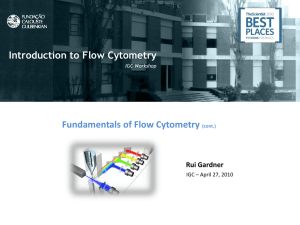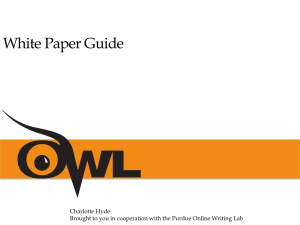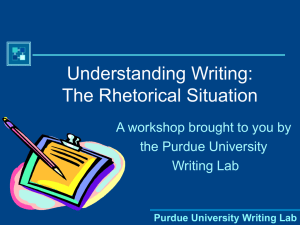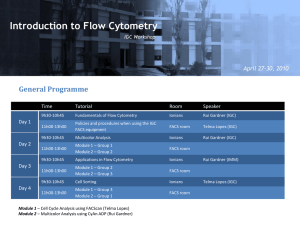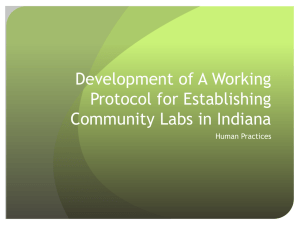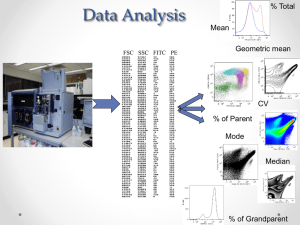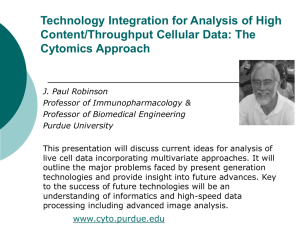Live Cell Imaging Applications in Confocal Microscopy
advertisement
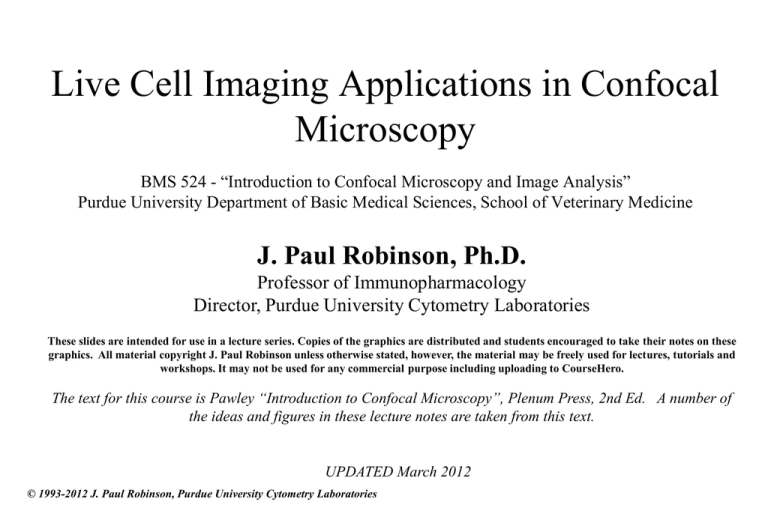
Live Cell Imaging Applications in Confocal Microscopy BMS 524 - “Introduction to Confocal Microscopy and Image Analysis” Purdue University Department of Basic Medical Sciences, School of Veterinary Medicine J. Paul Robinson, Ph.D. Professor of Immunopharmacology Director, Purdue University Cytometry Laboratories These slides are intended for use in a lecture series. Copies of the graphics are distributed and students encouraged to take their notes on these graphics. All material copyright J. Paul Robinson unless otherwise stated, however, the material may be freely used for lectures, tutorials and workshops. It may not be used for any commercial purpose including uploading to CourseHero. The text for this course is Pawley “Introduction to Confocal Microscopy”, Plenum Press, 2nd Ed. A number of the ideas and figures in these lecture notes are taken from this text. UPDATED March 2012 © 1993-2012 J. Paul Robinson, Purdue University Cytometry Laboratories Goals of this lecture • Identify applications of imaging related to live cell work • Identify tools useful for doing live cell work • Identify reagents compatible with live cell imaging • Identify problems associated with live cell imaging • Show some examples of live cell imaging © 1993-2012 J. Paul Robinson, Purdue University Cytometry Laboratories Applications • • • • • • • Organelle Structure Probe ratioing Conjugated antibodies DNA/RNA Cytochemical Identification Oxidative Metabolism Exotic Applications © 1993-2012 J. Paul Robinson, Purdue University Cytometry Laboratories Applications • Organelle Structure & Function – Mitochondria (Rhodamine 123) – Golgi (C6-NBD-Ceramide) – Actin (NBD-Phaloidin) – Lipid (DPH) © 1993-2012 J. Paul Robinson, Purdue University Cytometry Laboratories top view Step 1: Cell Culture Step 2: Cell Wash Step 3: Transfer to LabTek plates side view Step 4: Addition of DCFHDA, Indo-1, or HE 1 2 3 4 5 6 7 8 170 M coverslip stimulant/inhibitor added 37o heated stage oil immersion objective confocal microscope © 1993-2012 J. Paul Robinson, Purdue University Cytometry Laboratories Below: the culture dishes for live cell imaging using a confocal microscope and high NA objectives. Lumascope • The LumaScope is a low price, compact, USB-based, inverted fluorescence microscope. The system fits on a shelf inside an incubator or inside a hood. It has a built-in camera and light source. This runs on a laptop/desktop using just one USB cable, captures fluorescence or brightfield images and has options of 2.5x, 4x, 10x, 20x, 40x and 100x (oil) lenses. The software allows to do time-laps study. The machine does not have a mechanical shutter to block the light (to avoid photo-toxicity or photo-bleaching), but the software can control the light to turn on/off to less expose the cells to the light. © 1993-2012 J. Paul Robinson, Purdue University Cytometry Laboratories Nikon live cell imaging © 1993-2012 J. Paul Robinson, Purdue University Cytometry Laboratories Image source: http://www.microscopyu.com/articles/livecellimaging/livecellmaintenance.html Live Cell Chambers © 1993-2012 J. Paul Robinson, Purdue University Cytometry Laboratories http://www.microscopyu.com/articles/livecellimaging/culturechambers.html Examples of micro-incubation systems Images from: http://www.harvardapparatus.com/webapp/wcs/stores/servlet/haisku3_10001_11051_68114_-1_HAI_ProductDetail_N_37474_37500_44260 © 1993-2012 J. Paul Robinson, Purdue University Cytometry Laboratories Confocal System Culture System Photos taken in Purdue University Cytometry Labs Photo taken from Nikon promotion material © 1993-2012 J. Paul Robinson, Purdue University Cytometry Laboratories Live cell manipulation devices Image source: http://www.warneronline.com/products.cfm?CFID=6704527&CFTOKEN=47754450 © 1993-2012 J. Paul Robinson, Purdue University Cytometry Laboratories LabtekTM culture chambers © 1993-2012 J. Paul Robinson, Purdue University Cytometry Laboratories http://www.microscopyu.com/articles/livecellimaging/culturechambers.html Useful cell lines © 1993-2012 J. Paul Robinson, Purdue University Cytometry Laboratories Table from: http://www.microscopyu.com/articles/livecellimaging/livecellmaintenance.html Growth conditions © 1993-2012 J. Paul Robinson, Purdue University Cytometry Laboratories Table from: http://www.microscopyu.com/articles/livecellimaging/livecellmaintenance.html Example of DIC and Fluorescence Giardia (DIC image) (no fluorescence) Human cheek epithelial cells (from JPR!) stained with Hoechst 33342 - wet prep, 20 x objective, 3 x zoom (Bio-Rad 1024 MRC) (Image from JPR lab) © 1993-2012 J. Paul Robinson, Purdue University Cytometry Laboratories (photo taken from a 35 mm slide and scanned - cells were live when photographed) (JPR lab) Fluorescence Microscope image of Hoechst stained cells (plus DIC) Image collected with a 470T Optronics cooled camera (Image from JPR lab) © 1993-2012 J. Paul Robinson, Purdue University Cytometry Laboratories Measurement of DNA # of Events G0-G1 • Use for DNA content and cell viability – 33342 for viability • Less needed to stain for DNA content than for viability – decrease nonspecific fluorescence • Low laser power decreases CVs © 1993-2012 J. Paul Robinson, Purdue University Cytometry Laboratories G2-M S Fluorescence Intensity PI - Cell Viability How the assay works: • PI cannot normally cross the cell membrane • If the PI penetrates the cell membrane, it is assumed to be damaged • Cells that are brightly fluorescent with the PI are damaged or dead Viable Cell Damaged Cell PI PI PI PI PI PI PI PI PI PI PI PI PI © 1993-2012 J. Paul Robinson, Purdue University Cytometry Laboratories PI 104 Fluorescence Transmission 102 oocysts Flow cytometric scatter plot of gamma irradiated C. parvum oocysts. The oocysts region is clearly distinguished from ghosts and debris. Images on the right show Sytox green fluorescence and transmission images of these regions. Note ghosts do not take up Sytox green dye. ghosts 10 1 Side Scatter 103 Flow Cytometry Dot Plot 10 0 debris Forward Scatter 100 101 102 103 Green Fluorescence © 1993-2012 J. Paul Robinson, Purdue University Cytometry Laboratories 104 Specific Organelle Probes Probe BODIPY NBD DPH TMA-DPH Rhodamine 123 DiO diI-Cn-(5) diO-Cn-(3) Site Excitation Golgi 505 Golgi 488 Lipid 350 Lipid 350 Mitochondria 488 Lipid 488 Lipid 550 Lipid 488 © 1993-2012 J. Paul Robinson, Purdue University Cytometry Laboratories Emission 511 525 420 420 525 500 565 500 BODIPY - borate-dipyrromethene complexes NBD - nitrobenzoxadiazole DPH - diphenylhexatriene TMA - trimethylammonium Organelle Function • • • • Mitochondria Endosomes Golgi Endoplasmic Reticulum © 1993-2012 J. Paul Robinson, Purdue University Cytometry Laboratories Rhodamine 123 Ceramides BODIPY-Ceramide DiOC6(3) Carbocyanine Calcium Related Applications • Probe Ratioing – Calcium Flux (Indo-1) – pH indicators (BCECF, SNARF) Molecule-probe Excitation Emission Calcium - Indo-1 Calcium- Fluo-3 Calcium - Fura-2 Calcium - Calcium Green Magnesium - Mag-Indo-1 Phospholipase A- Acyl Pyrene 351 nm 488 nm 363 nm 488 nm 351 nm 351 nm 405, >460 nm 525 nm >500 nm 515 nm 405, >460 nm 405, >460 nm © 1993-2012 J. Paul Robinson, Purdue University Cytometry Laboratories Probes for Ions • • • • INDO-1 QUIN-2 Fluo-3 Fura -2 Ex350 Ex350 Ex488 Ex330/360 © 1993-2012 J. Paul Robinson, Purdue University Cytometry Laboratories Em405/480 Em490 Em525 Em510 Ionic Flux Determinations • Calcium • Intracellular pH Indo-1 BCECF How the assay works: • Fluorescent probes such as Indo-1 are able to bind to calcium in a ratiometric manner • The emission wavelength decreases as the probe binds available calcium 600 400 200 RATIO [short/long] 800 1000 Ratio: intensity of 460nm / 405nm signals 0.8 0 Stimulation 0 36 72 108 Time (Seconds) 144 180 Flow Cytometry 0.7 0.6 0.5 0.4 0.3 0.2 0.1 Time (seconds) 0 0 Image Analysis © 1993-2012 J. Paul Robinson, Purdue University Cytometry Laboratories 50 100 150 200 Calcium Flux Flow Cytometry Image Cytometry Ratio: intensity of 460nm / 405nm signals 1000 0.8 0.7 800 0.6 600 0.5 400 0.4 0.3 200 0.2 0 Stimulation 0 36 72 108 Time (Seconds) 144 0.1 180 Time (seconds) 0 0 © 1993-2012 J. Paul Robinson, Purdue University Cytometry Laboratories 50 100 150 200 Oxidative-Related Reactions • • • • • Superoxide Hydrogen Peroxide Glutathione levels Nitric Oxide Nitric Oxide Hydroethidine Dichlorofluorescein Monobromobimane Dichlorofluorescein DAF-FM Nitric Oxide Indicators: DAF-FM and DAF-FM Diacetate D-23841 DAF-FM (4-amino-5-methylamino- 2',7'-difluorescein) D-23842 DAF-FM diacetate (4-amino-5-methylamino- 2',7'-difluorofluorescein diacetate) D-23844 DAF-FM diacetate (4-amino-5-methylamino- 2',7'-difluorofluorescein diacetate) *special packaging* (Data from Invitrogen website) © 1993-2012 J. Paul Robinson, Purdue University Cytometry Laboratories DAF-FM DAF-FM Diacetate (4-Amino-5-Methylamino-2',7'-Difluorofluorescein Diacetate) • DAF-FM is not a reversible equilibrium sensor, limiting its ability to track rapid fluctuations of the target analyte (NO) in real time. • DAF-FM is a reagent that is used to detect and quantify low concentrations of nitric oxide (NO). It is essentially nonfluorescent until it reacts with NO to form a fluorescent benzotriazole. DAF-FM fluorescence can be detected by any instrument that can detect fluorescein, including flow cytometers, microscopes, fluorescent microplate readers and fluorometers. • Ex/Em of DAF-FM: ~495/515 nm • The fluorescence quantum yield of DAF-FM is ~0.005, but increases about 160-fold, to ~0.81, after reacting with NO Data and Image from http://products.invitrogen.com/ivgn/product/D23842 © 1993-2012 J. Paul Robinson, Purdue University Cytometry Laboratories DCFH-DA DCFH DCF 2’,7’-dichlorofluorescin diacetate O O CH3-C-O O O-C-CH3 Cl 2’,7’-dichlorofluorescin Cl H COOH O HO Cellular Esterases OH Cl Fluorescent Cl H COOH Hydrolysis 2’,7’-dichlorofluorescein O HO O H 2O 2 Cl Oxidation DCFH-DA Cl H COOH Neutrophils DCFH-DA 8 0 Monocytes H 2O 2 counts DCFH 60 DCF PMA-stimulated PMN Control 40 20 Lymphocytes 0 . 1 © 1993-2012 J. Paul Robinson, Purdue University Cytometry Laboratories 1 100 log FITC 10 Fluorescence 100 0 Hydroethidine Ethidium HE H2N NH2 H N O2- H2N NH2 N + Br CH2CH3 - CH2CH3 Phagocytic Vacuole NADPH Oxidase NADPH O2 HE O2- NADP SOD O2H2O2 DCF H2O2 OH- Example: Neutrophil Oxidative Burst © 1993-2012 J. Paul Robinson, Purdue University Cytometry Laboratories DCF Macrovascular Endothelial Cells in Culture 0 Time (minutes) © 1993-2012 J. Paul Robinson, Purdue University Cytometry Laboratories 60 Hydrogen peroxide measurements with DCFH-DA 1 2 3 4 Change in fluorescence was measured using Bio-Rad software and the data exported to a spread sheet for analysis. 5 525 nm Step 7B: Export data from Excel data base to Delta Graph % change (DCF fluorescence) Step 6B: Export data from measured regions to Microsoft Excel 2000 1800 1600 1400 1200 1000 800 600 400 200 0 cell 1 cell 2 cell 3 cell 4 cell 5 0 500 © 1993-2012 J. Paul Robinson, Purdue University Cytometry Laboratories 1000 1500 2000 2500 3000 Time in seconds Superoxide measured with hydroethidine cell 1 Change in fluorescence was measured using Bio-Rad software and the data exported to a spread sheet for analysis. cell 3 cell 4 cell 2 Export data from measured regions to Microsoft Excel Export data from Excel data base to Delta Graph %change (DCF fluorescence) cell 5 1800 1600 1400 1200 1000 800 600 400 cell 1 cell 2 cell 3 cell 4 200 0 cell 5 -200 200 400 600 800 1000 1200 1400 1600 1800 Time in seconds © 1993-2012 J. Paul Robinson, Purdue University Cytometry Laboratories H2O2 stimulation and DCF & Ethidium loading in Rat Pulmonary Artery Endothelial Cells 24 treatments - 5000 cells each 200 ENDO HBSS ENDO HBSS TNFa ENDO L-arg ENDO/ L-arg TNFa ENDO/ D-arg ENDO/ D-arg TNFa Endo + 200uM H2O2 Endo + 200uM H2O2 Endo + 200uM H2O2 Endo / TNFa + 200uM H2O2 Endo / TNFa + 200uM H2O2 Endo / TNFa + 200uM H2O2 Confocal System Fluorescence Measurements . 180 160 DCF Fluorescence Mean EB Fluorescence Endo / L-arg + 200uM H2O2 Endo / L-arg + 200uM H2O2 Endo / L-arg + 200uM H2O2 Endo / L-arg TNFa + 200uM H2O2 Endo / L-arg TNFa + 200uM H2O2 Endo / L-arg TNFa + 200uM H2O2 Endo / D-arg + 200uM H2O2 Endo / D-arg + 200uM H2O2 Endo / D-arg + 200uM H2O2 Endo / D-arg TNFa + 200uM H2O2 Endo / D-arg TNFa + 200uM H2O2 Endo / D-arg TNFa + 200uM H2O2 140 120 100 80 60 40 20 200uM H2O2 added 200uM H2O2 added 0 0 20 40 60 80 100 120 140 © 1993-2012 J. Paul Robinson, Purdue University Cytometry Laboratories Time (minutes) Time (seconds) pH Sensitive Indicators Probe Excitation Emission • SNARF-1 488 575 • BCECF 488 440/488 525/620 525 [2’,7’-bis-(carboxyethyl)-5,6-carboxyfluorescein] © 1993-2012 J. Paul Robinson, Purdue University Cytometry Laboratories Exotic Applications of Confocal Microscopy • FRAP (Fluorescence Recovery After Photobleaching) • Release of “Caged” compounds • Lipid Peroxidation (Parinaric Acid) Difficult to do with confocal, but possible with 2P (excitation is 325 nm) • Membrane Fluidity (DPH) © 1993-2012 J. Paul Robinson, Purdue University Cytometry Laboratories “Caged” Photoactivatable Probes Principle: Nitrophenyl blocking groups e.g. nitrophenyl ethyl ester undergoes photolysis upon exposure to UV light at 340-350 nm Available Probes • • • • • • • Ca++: Nitr-5 Ca++ - buffering: Diazo-2 IP3 cAMP cGMP ATP ATP--S © 1993-2012 J. Paul Robinson, Purdue University Cytometry Laboratories Release of “Caged” Compounds UV Beam Culture dish Release of “Cage” © 1993-2012 J. Paul Robinson, Purdue University Cytometry Laboratories Release of Caged Compounds UV excited CONTROL STUDY Fluorescence Emission at 515 nm 250 C Control Region 200 150 100 50 0 0 100 200 300 400 Time (seconds) CONTROL © 1993-2012 J. Paul Robinson, Purdue University Cytometry Laboratories Fluorescence Emission at 515 nm D Release of Caged Nitric Oxide in Attached PMN 250 200 150 100 50 0 0 20 40 60 80 100 120 140 160 Time (seconds) after UV FLASH Membrane Polarization • Polarization/fluidity Diphenylhexatriene How the assay works: The DPH partitions into liphophilic portions of the cell and is excited by a polarized UV light source. Polarized emissions are collected and changes can be observed kinetically as cells are activated. An image showing DPH fluorescence in cultured endothelial cells. © 1993-2012 J. Paul Robinson, Purdue University Cytometry Laboratories Calcium ratios with Indo-1 1 1 2 2 3 3 460 nm 405/35 nm Changes in the fluorescence were measured using the Bio-Rad calcium ratioing software. The same region in each wave length was measured and the relative change in each region was recorded and exported to a spread sheet for analysis.. Export data from measured regions to Microsoft Excel Ratio: intensity1 (460nm) / intensity2 (405/35nm) 0.8 Export data from Excel data base to Delta Graph cell 1 cell 2 cell 3 0.7 0.6 0.5 0.4 0.3 0.2 0.1 0 0 © 1993-2012 J. Paul Robinson, Purdue University Cytometry Laboratories 50 100 150 200 FRAP %F Intense laser Beam Bleaches Fluorescence Time Recovery of fluorescence Zero time 10 seconds © 1993-2012 J. Paul Robinson, Purdue University Cytometry Laboratories 30 seconds 4D confocal microscopy • Time vs 3D sections • Used when evaluating kinetic changes in tissue or cells • Requires fast 3D sectioning • Difficult to evaluate © 1993-2012 J. Paul Robinson, Purdue University Cytometry Laboratories 4D Imaging Time 1 2 3 4 5 This could also be achieved using an X-Z scan on a point scanner. © 1993-2012 J. Paul Robinson, Purdue University Cytometry Laboratories Imaging 3D ECM structures • Mainly collagen based materials • Usually 40-120 microns thick • Require both transmitted and fluorescent signals • Often require significant image processing to extract information © 1993-2012 J. Paul Robinson, Purdue University Cytometry Laboratories © 1993-2012 J. Paul Robinson, Purdue University Cytometry Laboratories © 1993-2012 J. Paul Robinson, Purdue University Cytometry Laboratories Thick Tissue - Bone and Cartilage • Very difficult to image thick specimens • Can use live specimens if appropriately stained • Special preparation techniques © 1993-2012 J. Paul Robinson, Purdue University Cytometry Laboratories Lecture Summary • Live cell applications are relatively common using confocal microscopy • Correct use of fluorescent probes necessary • Temperature and atmosphere control may be required • Thick specimens often require advanced image processing • Exotic applications are potentially useful • A limited window of time is available to image live cells before cells deteriorate © 1993-2012 J. Paul Robinson, Purdue University Cytometry Laboratories
